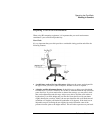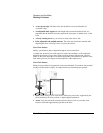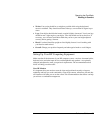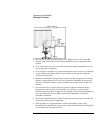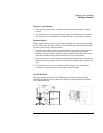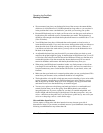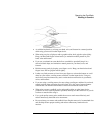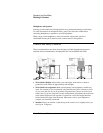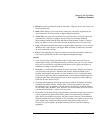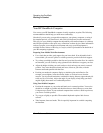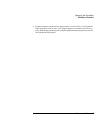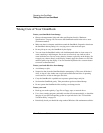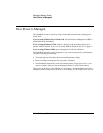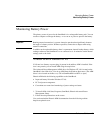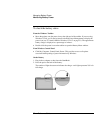
Operating the OmniBook
Working in Comfort
Reference Guide 45
• Head: Do not tilt your head forward by more than 15 degrees, and try not to turn your
head toward the side.
• Back: While sitting at your work surface, make sure your back is supported by the
chair’s backrest in an erect position or angled slightly backwards.
• Arms: Make sure your arms and elbows are relaxed and loose, with your upper arm
perpendicular to the floor or slightly forward. Keep your forearms and hands
approximately parallel with the floor with elbows bent between 70 and 115 degrees.
Keep your elbows close to your sides (less than 20 degrees away from your body).
• Legs: Your thighs should be horizontal or angled slightly downward. Your lower legs
should be near a right angle to your thighs. Make sure there is sufficient room under
the work surface for your legs.
• Feet: If after adjusting your chair you cannot rest your feet comfortably on the floor,
use a footrest, preferably one that can be adjusted in height and angle.
Overall
• Look away from the screen from time-to-time to help reduce eyestrain. Focus on
distant objects briefly, and blink periodically to lubricate your eyes. You also should
have your eyes checked on a regular basis and ensure your eyeglass prescription is
suitable for working on a monitor screen.
• Remember to occasionally shift position and move your body. Keeping your body in
one position for long periods is unnatural and stressful. When prolonged work is
required, take frequent short breaks. As a rule of thumb, a five- or ten-minute break
every hour is a good idea. Short, frequent breaks are more beneficial than longer less
frequent breaks. Data show that people who work for long periods of time without a
break may be more prone to injury.
• Changing tasks frequently will help prevent muscle stiffness. Examples: alternating
between keyboarding, reading, writing, filing, and moving around in your work
environment, helps you maintain a relaxed posture. Occasionally stretch the muscles
in your hands, arms, shoulders, neck, and back. You should stretch at least as often as
you take brief task breaks—at least once every hour.
• Discomfort may be alleviated by using alternative ergonomic designs and accessories
such as ergonomically personalized chairs, palm rests, keyboard trays, alternative
input devices, prescription eyeglasses, anti-glare screens, and more. Seek additional
information from the sources available to you, including your employer, doctor, local
office supply store, and the information sources listed in the online version of
Working in Comfort, which is preloaded on the hard disk of your HP computing
equipment.



